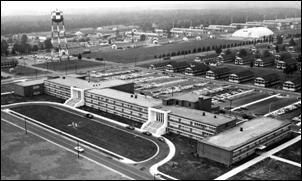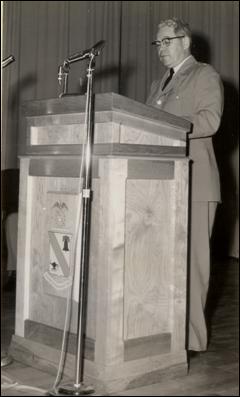Continuity gives us roots; change gives us branches, letting us stretch and grow and reach new heights.

Nineteen fifty-eight, it wasn't all tailfins and hoola hoops. That was the year Egypt and Syria launched the United Arab League. Castro's revolutionary army began its attacks on Havana. Charles De Gaulle came out of retirement to lead France. And 5,000 U.S. Marines landed in Beirut, Lebanon, to protect the pro-Western government there.
Here at Fort Lee sixty-three company grade Quartermasters (with names like Gregg, Gaskill, Hunzeker, Dukes, and Skeen who all later became general officers) arrived in September for the start of Officer Advanced Course 59-1. Moving about post they had to have noticed changes in all directions — including a huge construction effort well underway in the vicinity of today's Seay Field. It was the building of Mifflin Hall.
Barely twenty years old, the vast majority of Fort Lee's buildings, classrooms, chapels, warehouses and theaters were wooden structures — so-called “temporary” facilities — built during World War II, that were now clearly showing their age. Most suffered from poor insulation, lack of air conditioning, antiquated heating equipment, and a host of other problems that left them ill-suited for educational purposes.
The installation already sported a new Post Theater, Larkin Hall, brick barracks and increased permanent housing. So why not a new Academic Building for the Quartermaster School? Representatives from Fort Lee (including the Commander, School Commandant, and the Education Advisor, Dr. Robert Allen) successfully argued the case before both the House and Senate Appropriations Committees. Congress thus approved $3.4 million in construction funds, and the J. Kennon Perrin Company out of Richmond broke ground on 17 March 1959.
It took a full two years for the construction to be completed. The new three-story facility was thought to include everything a truly modern “schoolhouse” could want, to include: a wide variety of classrooms capable of accommodating nearly 700 students, offices for upwards of 415 staff and faculty members, a bookstore, mailroom, barber shop, 300-plus-seat cafeteria and a Main Auditorium with over 500 seats. This 143,000-square-foot building had no less than 184 rooms — with 43 doors leading outside, and another 373 for interior use.
A 66-seat-capacity Model Theater on the second floor demonstrated in a very concrete fashion 1960s style, state-of-the-art “over the shore logistics.” Upstairs on the third floor was one of the building's most important new features, a fully equipped television studio where filming or live presentations could take place and be immediately broadcast over WFL-TV and show up on closed circuit monitors throughout the installation. They would later use this system to teach over 3,000 Army Reservists during the annual Logistical Exercise (LOGEX) rotation held at nearby Fort Pickett.

As one of his nearly last official duties as The Quartermaster General (before earning a third star and becoming head of the newly created Defense Supply Agency), MG Andrew T. McNamara traveled to Fort Lee on 19 May 1961 to dedicate the new building in honor of the first Quartermaster General. “I don't know what Pennsylvania has done about perpetuating the memory of Tom Mifflin,” said General McNamara in his dedicatory remarks, “but I think it is singularly appropriate that we should inscribe his name upon this great new headquarters of the Quartermaster School, symbolizing as it does our highest aspiration in Quartermaster training and service.”
Mifflin Hall was dedicated in the name of Major General Thomas Mifflin who on 14 August 1775, was selected by General Washington as the Continental Army's first Quartermaster General.
Mifflin Hall became a beehive of activity during the sixties and early seventies, with tens of thousands of student graduates passing through its doors because of the Vietnam War. In recognition of more than fifty years service to the nation, a 200-pound bronze plaque (the Distinguished U.S. Army School Award) was presented to the Quartermaster School in December 1966 and placed in Mifflin Hall. A few years later, during MG John D. McLaughlin's tenure as Fort Lee Commander/QM School Commandant (1969-73) the Post Headquarters moved from Building 8000, where it had been since World War II, into Mifflin Hall. Twenty years after that, in 1990, a TRADOC-directed installation reorganization and realignment created the U.S. Army Combined Arms Support Command, and transferred control of the post to the CASCOM Commander.
During her nearly 50-year lifespan “Old Mifflin” has more than fulfilled her primary mission of training Quartermaster Soldiers and developing Logistics Leaders for the 21st Century. Until the beginning of 2010 she spawned new graduates virtually on a daily basis. And her halls are now truly hallowed — gone are the Command portraits, prints, and memorialization displays and exhibits, and other reminders of the Corps' illustrious past. Plus hundreds of plaques, large and small, bearing the names of the fallen, Medal of Honor recipients, outstanding instructors, and those whom the Quartermaster Regiment has seen fit to recognize as Distinguished Members and Units, and Hall of Fame inductees. Whose combined effect made this a very special place indeed.
It is with a hint of sadness therefore that Mifflin Hall is in the process of being torn down. But the Sustainment Center of Excellence (or SCoE) Headquarters Building just across the street on what used to be Sergeant Seay field is scheduled to be named Mifflin Hall to carry on this tradition.
So once again the old is poised to make way for the new. As Mifflin Hall passes into History — and becomes a part of the past remembered.